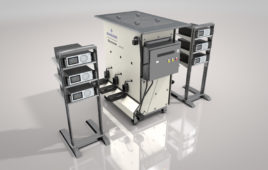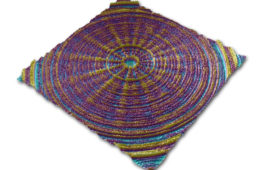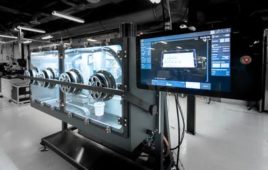Overmolding is an injection molding process typically used for high-volume production. It is a way to add an additional layer of resin to a part that has already been injection molded. The main reason to overmold is to develop characteristics unavailable from a single material. These characteristics include improving the grip or feel of a part, delivering a specific cosmetic appearance or coloration, or to reduce assembly steps. For example, a soft rubber-type material overmolded to a hard substrate can improve grip: think of a hand tool like pliers. For appearance, check out many consumer items, such as toothbrushes that often need a specific look. And because overmolding delivers good adhesion between different materials, it can reduce hand assembly. Many products are produced through overmolding.
The more common methods of overmolding include two-shot molding and pick-n-place molding. Two-shot molding uses one mold. Pick-n-place molding uses two molds.
In two-shot molding, a molded substrate of one material is overmolded with another material. Two-shot molding uses one of three main methods: Transfer overmolding, rotational overmolding, and core-back overmolding.
In pick-n-place overmolding, a number of substrate parts are molded at one time, and then put into a larger second set of molds where a different resin is overmolded onto them to complete the parts. In this method it is necessary to have a warm substrate to reduce the risk of non-adhesion. Overmolding a hard material over another hard material, such as a polycarbonate over a polycarbonate, the adhesion isn’t as at-risk as when you’re dealing with maybe a chemical bond TP or TPU on an elastomeric material. These processes can use the heat of a substrate to facilitate the chemical bond. In this case it could be helpful to encourage a mechanical bond on top of the chemical to ensure that over time that overmold does not shift or delaminate.
Now let’s examine in more detail the three methods of two-shot molding.
Transfer overmolding is commonly used in multi-cavity production. A robotic arm removes the substrate part from one mold and places that part into another mold. The overmold resin is injected to fill the space between the substrate part and this larger second mold. Meanwhile, the first mold is filled with material for the next substrate part. Because the process molds multiple parts in succession, it is an efficient method of overmolding.
Rotational overmolding uses a two-barrel press and a rotating platen. Once a single substrate has been molded, the platen is rotated into an overmolding station where an additional material is injected onto it. The mold is basically moved from one injection station to another to receive additional overmold materials. This is a highly efficient process for high volume or for a good mechanical application.
Core-back overmolding is a method used with parts that are highly linear or with specific geometries. The mold is built to have a sliding section that is pulled back once the initial substrate is molded to allow for the second material to be injected. This process is typically used where the investments is in creating a precision tool that allows you to use a single cavity, but multiple shots inside of that cavity.
In each of these two-layer methods, the initial substrate is usually warm to aid the chemical bonding. These methods are highly automated and can handle production volumes to 100,000 or more.
The choice of which method to use can involve a number of factors, such as are you in the development or production stage, and what kind of adhesion do you need? In many cases it is best to talk with the injection molding company’s application engineers to choose the best method for your part.
Filed Under: Molding • injection molding components







Tell Us What You Think!